What kinds of language do students need to learn to work and think like artists?
Our practitioner inquiry into this question included 80 ESL, dual language, classroom and art teachers, ArtsConnection artists and staff members. We concluded that students need to use language to:
1. Understand the structures, principles, concepts, and vocabulary of the art form, and understand criteria used to assess work within the art form in order to improve their work, i.e., language to help them work like artists. Much of this language crosses disciplines.
2. Brainstorm ideas and make artistic choices, incorporating personal invention with their understanding of the structures and criteria demanded by the art form.
3. Explain their choices. Discuss ideas, negotiate, and compromise in collaboration with others. Give feedback to peers on their own artistic choices.
4. Describe what a work of art communicates to them.
The videos in this section offer examples of the many ways teachers and artists help students use language to learn to work and think like artists.

Teaching Artist Tarik Davis works with ELA teachers at PS 153q in Maspeth, Queens NY to help ELL students take risks speaking English through rehearsal and performance by saying “Yes, and…” in improvisation. By building details together and engaging in peer feedback, fourth grade students build original scenes for presentation.
Tags: 153Q grade 4 theater

The first goal of teaching artist Chris Heller’s theater residency at P.S. 239Q is to create a safe space for 4th and 5th grade ELLS to take risks in theater. Through scaffolded warm-up activities students progress through silent, physical warm-ups, to games in which they’re asked to say just one word or sound, to eventually […]
Tags: 239Q DELLTA ELLs grade 4 grade 5 theater
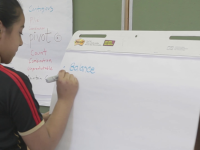
Teaching Artists Alda Reuter and Peter Bogdonos generate vocabulary charts with their ELL students. We see how using the charts in dance work helps ground the learning of vocabulary through the physical activity of dance. Jason, an ELL student, explains how he uses the dance vocabulary across his curriculum.
Tags: 150Q charts clear criteria dance performance
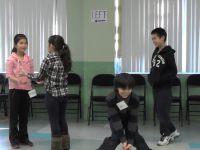
Teaching Artist Lindsay MacNaughton and the ESL teachers at PS 229 in Queens, NY share strategies for working with Beginner ELLs. Amanda, a recent arrival from China, is learning English through her participation in Ms. Lindsay’s theater class.
Tags: 229Q ELLs performance theater
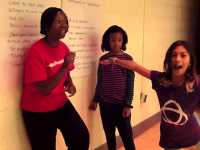
Students in Maya’s 4/5th grade class are learning the beginning of a piece of choreography. The artists use observation and description to help students understand the movement sequence, allowing multiple entry points for different kinds of learners. This experience helps students to learn and understand a piece of choreography, and it builds skills students will […]
Tags: building artistic voice clear criteria dance The Creative Learning Loop The Earth School
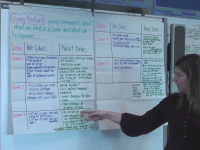
Fourth grade students in Chris Heller’s theater residency at PS 239q devise scenes based on The Private Notebook of Katie Roberts, Age 11, a text from the curriculum. Throughout the process students share their scenes and give each other feedback. Feedback is charted to help students remember and apply feedback. Follow one student, Noel, as […]
Tags: 239Q feedback formative assessment grade 4 revision theater
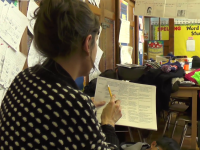
Using a rubric for theater, teaching artist Jenny Campbell leads students in Ms. Wong’s class at PS 163Q through the process of creating scenes in small groups that take place in a vehicle. The students use the rubric to assess their progress and to assess and give feedback to their peers during presentation and performance. […]
Tags: 163Q clear criteria rubric theater

Dance Artist Mei-Yin Ng is teaching a traditional Chinese ribbon dance, and at the same time lays the groundwork for practicing peer feedback. Ms. Hunt’s 4th grade students work in partners to observe each other and then give verbal feedback.
Tags: 20Q dance feedback formative assessment grade 4

It is the first day of dance class, and many of Ms. Alvarado’s Dual Language students have never participated in formal dance training. Teaching Artist Jennifer Golonka clearly introduces her Toolbox of Dance Elements, allowing all of the students to participate in dance-making by the end of this first class.
Tags: 19Q clear criteria dance formative assessment toolbox











